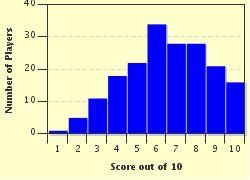Quiz Answer Key and Fun Facts
1. Why does the uakari have a bald head and brightly colored face?
2. The vervet monkey is known for a behavior called allomothering, which is best described as which of the following?
3. The vampire bat is a vicious animal known to eat their own young.
4. Why is the vaquita a difficult animal to photograph?
5. The Ugandan kob is a sub-Saharan antelope which is least likely to be found in which of these countries?
6. In North America, what is the more common name for the small rodent more properly called a vole?
7. What kind of animal is the Asian urial?
8. Which of these words is an alternate name for the Canadian porcupine?
9. If I tell you that "Unau" is a Portuguese word, derived from the South American language known as Tupian, can you tell me in which of the following countries will you most probably see this word used as the name or the two-toed sloth?
10. The gentle vicuna was nearly hunted to extinction in the 1970s due to desire for which of the following things?
Source: Author
dcpddc478
This quiz was reviewed by FunTrivia editor
Tizzabelle before going online.
Any errors found in FunTrivia content are routinely corrected through our feedback system.

